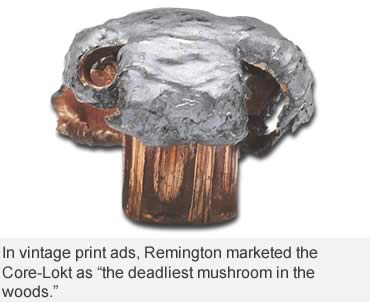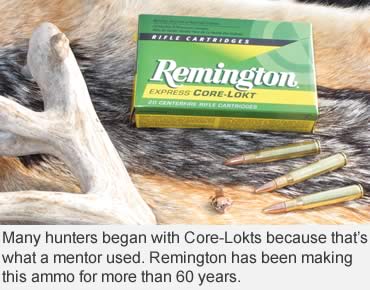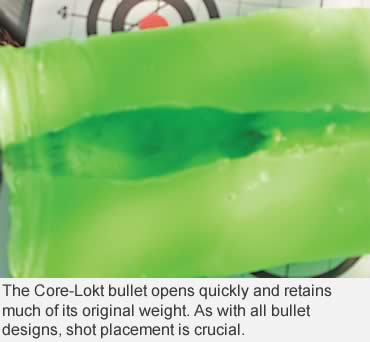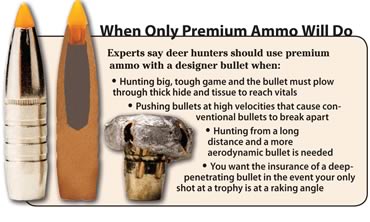Granddad’s ammo saves bucks and still brings home the bucks.
Photo: A 150-grain Core-Lokt pointed soft point instantly dropped this 9-point Kansas whitetail. The Marlin XL7S rifle with a stainless action and barrel is new this year.
Let’s say it didn’t already exist, and you wanted to develop a good-performing, inexpensive deer cartridge. Whitetails are thin-skinned and have a relatively narrow chest cavity. Not a lot of punch is required to get a bullet past the ribs and into the boiler room. Such a bullet would need to open up relatively fast to take out the vitals.
A lead bullet is the logical choice for price, availability, ease of manufacturing and operating velocity. Even a relatively slow-moving lead conical muzzleloading bullet will penetrate, expand and take out a deer’s vitals. Encasing that pure-lead bullet in a thin copper or guiding metal jacket would eliminate lead bore fouling and increase bullet speed and weight retention.
Any deer cartridge for the masses would also be widely available in all the popular calibers and many less-popular ones. The bullet would be lethal out to 300 yards and be reliable as rain.
This everyman’s deer bullet, of course, already exists. In fact, it has been around longer than huntable populations of white-tailed deer in many areas.
 When I started deer hunting in central Texas in the 1960s, whitetails were not scarce as they were in many other parts of the U.S. In Texas and elsewhere, Remington Core-Lokts and Winchester Power Points were the most popular deer cartridges. The choice was easy. Whichever brand of = ammo your dad, uncle or granddad used, that’s what you carried. Both are still popular today, although many hunters prefer premium loads with designer bullets for improved accuracy or deeper penetration. Lead- jacketed bullets aren’t meant for punching through a lot of muscle and bone to take out vitals.
When I started deer hunting in central Texas in the 1960s, whitetails were not scarce as they were in many other parts of the U.S. In Texas and elsewhere, Remington Core-Lokts and Winchester Power Points were the most popular deer cartridges. The choice was easy. Whichever brand of = ammo your dad, uncle or granddad used, that’s what you carried. Both are still popular today, although many hunters prefer premium loads with designer bullets for improved accuracy or deeper penetration. Lead- jacketed bullets aren’t meant for punching through a lot of muscle and bone to take out vitals.
Bullet failure on a Canada moose hunt is what prompted Bob Nosler to develop the Nosler Partition bullet in 1946. Its dual-core construction ensures penetration at a broad range of velocities.
For decades, if you wanted to shoot the Partition, you had to handload it. That changed when Federal began offering a Partition load in 1977. There was a pent-up demand for that bullet among the many hunters who did not reload.
 After the Partition cartridge came the Game King. Best-selling Federal Premium loads today include the Nosler Ballistic Tip, Federal Trophy Bonded Tip, Nosler Partition, Sierra GameKing and the Barnes Triple Shock, in that order. I’ve taken deer with all these cartridges with excellent results.
After the Partition cartridge came the Game King. Best-selling Federal Premium loads today include the Nosler Ballistic Tip, Federal Trophy Bonded Tip, Nosler Partition, Sierra GameKing and the Barnes Triple Shock, in that order. I’ve taken deer with all these cartridges with excellent results.
Premium bullets are a must in magnum rounds that push bullets at blistering velocities, around 3,000 feet per second or faster. At such speeds, conventional bullets lose their jackets and break apart.
A premium bullet is also a must when hunting with fat overbore cartridges like the .25 STW.
Taking game at exceedingly close range also requires a tough bullet. And if you want the most aerodynamic bullet for long-range accuracy, you need a sleek bullet with a high ballistic coefficient.
Although I hunt with premium bullets most of the time — I consider them good insurance in the event a trophy whitetail appears at a less-than optimal angle. I must point out that it would take brute of a whitetail to tempt me to take such a shot.
I don’t feel disadvantaged using jacked lead-core ammo, so I should use them more often. Millions of deer have fallen to them. As with all hunting bullets, shot placement is the key. Did I mention I don’t take risky shots?
 Remington says the Core-Lokt is the original controlled-expansion bullet. The copper jacket is “locked” to a solid lead core, hence the name.
Remington says the Core-Lokt is the original controlled-expansion bullet. The copper jacket is “locked” to a solid lead core, hence the name.
There are soft point and pointed soft point versions of Core-Lokts in a broad range of calibers and bullet weights.
Last December, I had an opportunity to get reacquainted with the 150-grain Core-Lokt in .30-06 and another load in .45-70. I was a guest of Marlin Firearms hunting on the Rim Rock Ranch in the rolling hills of southeast Kansas.
Ranch owner and outfitter Kirk Kelso has access to 20,000 acres of hunting property, most of it within a short drive of the lodge headquarters. Kelso is a good friend of well-known shooting writer Craig Boddington, who lives nearby.
The timing couldn’t have been better. It was opening day of the firearms deer season, the weather was frosty and bucks were actively trailing does.
On the second day of the hunt, a buck emerged from a creek bottom and immediately spotted me in a ladder stand 20 yards ahead. It was a typical Mexican standoff situation common to bowhunting.
I usually try not to look into a deer’s eyes, but it was too late. Seconds later, he was gone. It was the biggest deer I saw during the hunt.
A chance at another buck came three days later. I’d traded the ladder stand for a tower blind and the lever-action rifle for a Marlin XL7S rifle in .30-06. The stainless version of the value-priced XL7 rifle is new this year. Like its predecessor, the rifle is exceptionally accurate and comes with an adjustable trigger.
 Around 2:30 p.m. a buck with a heart-shaped rack appeared on a field edge. Deer were feeding on soybeans nearby. I raised the rifle and pushed off the safety.
Around 2:30 p.m. a buck with a heart-shaped rack appeared on a field edge. Deer were feeding on soybeans nearby. I raised the rifle and pushed off the safety.
Aiming for the off shoulder, I pressed the trigger. The 150-grain Remington Core-Lokt PSP bullet punched through shoulder bone, fractured a rib, took out the top of the heart, broke another rib and lodged square in the off shoulder.
I lasered the distance to the downed buck: 157 yards.
Later I weighed the recovered bullet. It retained 60.1 percent of its original weight.
There are more advanced bullet designs that retain 90-plus percent of their weight. Others are more accurate or will reliably expand at a slower velocity 400 yards downrange.
Many hunters don’t need a bullet that can handle those extremes. All they want is a deer at their feet at the end of the day. The jacketed lead-core bullet worked for granddad, and still does today.
Read Recent GunHunter Articles:
• Know Your Limitations: Don’t attempt a shot in the field you haven’t practiced at the range.
• Sage Goats With a Slug Gun? The author travels to Wyoming to push the envelope of slug gun performance.
This article was first printed in the September 2011 edition of Buckmasters GunHunter Magazine.